fold seats AUDI S8 2012 Owners Manual
[x] Cancel search | Manufacturer: AUDI, Model Year: 2012, Model line: S8, Model: AUDI S8 2012Pages: 300, PDF Size: 75.06 MB
Page 59 of 300
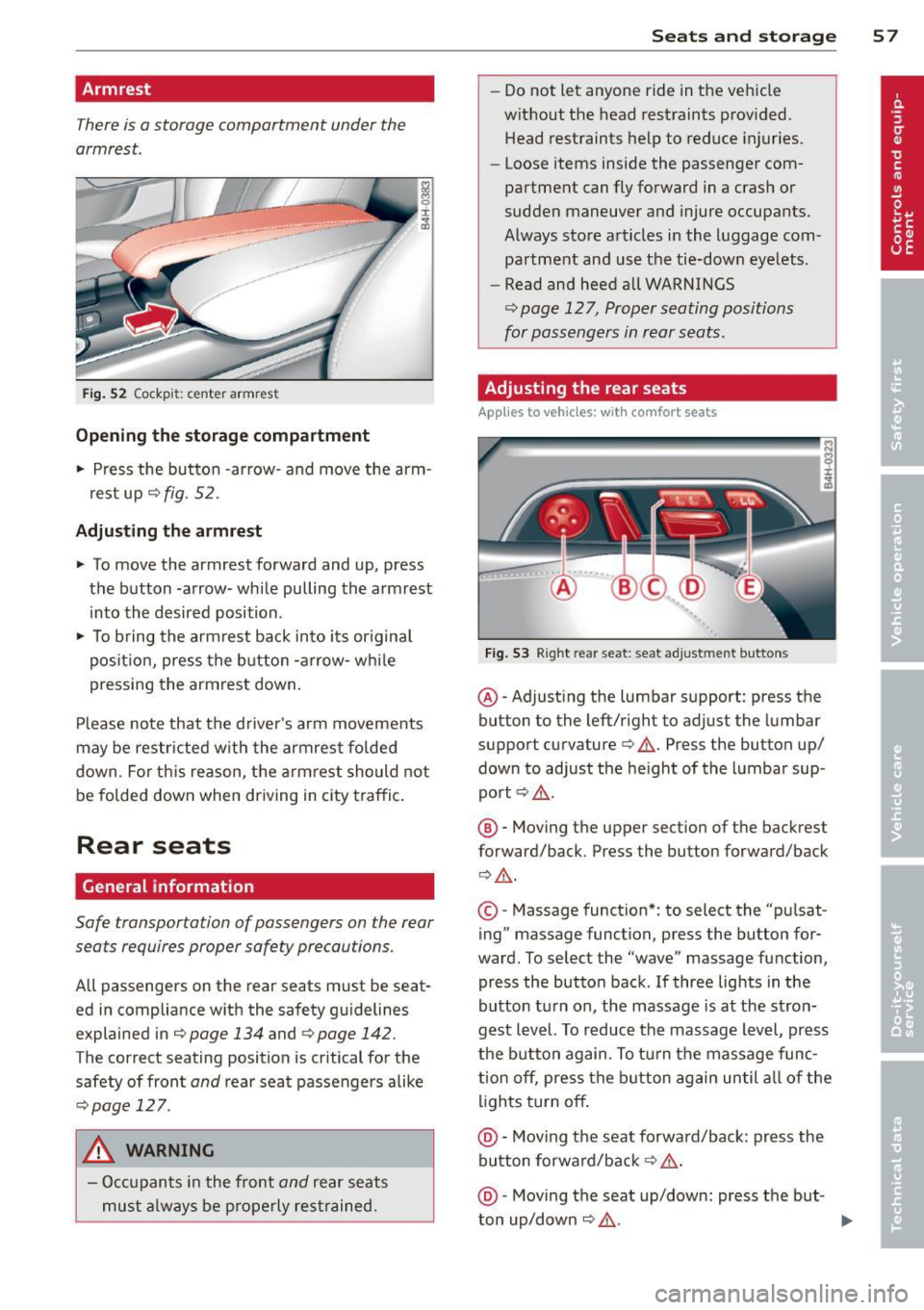
Armrest
There is a storage compartment under the
armrest .
Fig. 52 Cockp it: ce nter armrest
Opening the storage compartment
.. Press the button -arrow- and
move the arm
rest up¢
fig. 52.
Adjusting the armrest
.. To
move the armrest forward and up, press
the button -arrow- while pulling the armrest
into the desired position .
.. To bring the armrest back into its or igina l
position, press the button -arrow- while
pressing the armrest down.
Please note that the driver's arm movements
may be restricted w ith the armrest folded
down. Fo r this reason, the armrest should not
be folded down when driving in city traffic.
Rear seats
General information
Safe transportation of passengers on the rear
seats requires proper safety precautions.
All passengers on the rear seats must be seat
ed in compliance with the safety guidelines
explained in
¢page 134 and qpage 142.
The correct seating position is critical for the
safety of front
and rear seat passengers alike
¢page 127.
A WARNING
- Occupants in the front
and rear seats
must always be properly restrained.
-
Seats and storage 57
- Do not let anyone ride in the vehicle
without the head restraints provided.
Head restraints help to reduce injuries .
- Loose items inside the passenger com
partment can fly forward in a crash or
sudden maneuver and injure occupants.
Always store articles in the luggage com
partment and use the tie-down eyelets.
- Read and heed all WARNINGS
¢ page 127, Proper seating positions
for passengers in rear seats.
Adjusting the rear seats
App lies to vehicles: wit h co mfort seats
Fig. 53 Right re ar seat: seat adjustment buttons
@ -Adjust ing the lumbar support: press the
button to the left/right to adjust the lumbar
support curvature¢ &.. Press the button up/
down to adjust the height of the lumbar sup
port ¢&,. .
@ -Moving the upper section of the backrest
forward/back. Press the button forward/back
Q &_ .
©-Massage function* : to select the "pu lsat
ing" massage function, press the button for
ward. To select the "wave" massage function,
press the button back. If three lights in the
button turn on, the massage is at the stron
gest level. To reduce the massage level, press
the button again. To turn the massage func
tion
off, press the button again until all of the
lights turn
off .
@ -Moving the seat forward/back: press the
button forward/back ¢ &,. .
@ -Moving the seat up/down: press the but-
ton up/down ¢ &,. . ..,_
Page 60 of 300
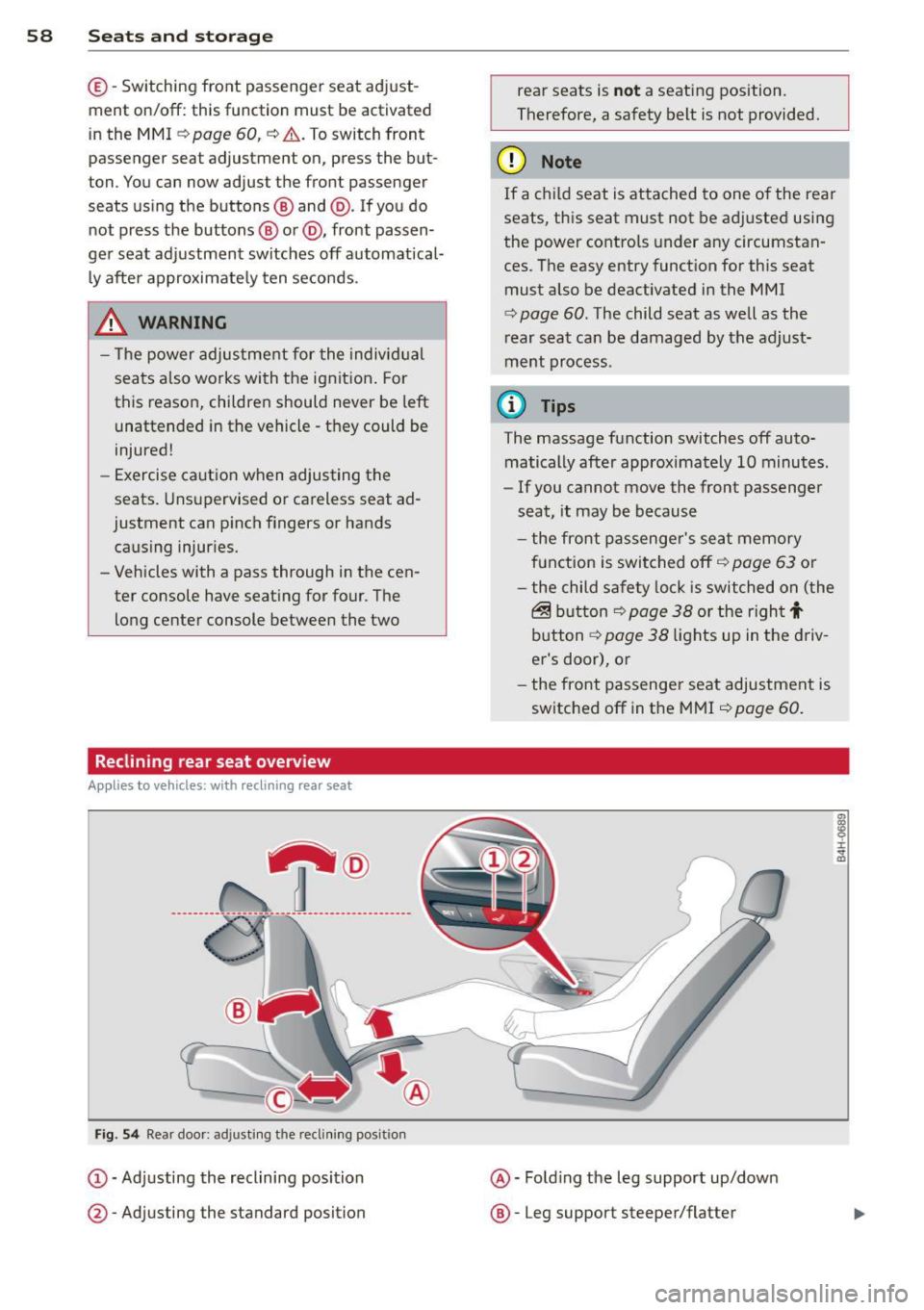
58 Seats and storage
© -Switching front passenger seat adjust
ment on/off: this function must be activated
in the MMI ¢
page 60, ¢& .To switch front
passenger seat adjustment on, press the but
ton. You can now adjust the front passenger
seats us ing the buttons @ and @. If you do
not press the buttons @ or@ , front passen
ger seat adjustment switches
off automatica l
ly after approximate ly ten seconds.
& WARNING
- T he power adjustment for the individ ual
seats also works with the ignition . For
this reason, children should never be left
unattended in the vehicle -th ey could be
injured!
- Exercise caution when adjusting the
seats. Uns upervised or careless seat ad
justment can p inch fingers or hands
causing injur ies.
- Vehicles with a pass through in the cen
ter console have seat ing for four. The
long center console between the two
Reclining rear seat overv iew
Applies to vehicles: with reclining rear seat
----------------- T ® ------ -
Fi g. 54 Rear doo r: ad justi ng the recli ning posit ion
(D -Adj usting the reclining posi tion
@ -Adjusting the standard position rear seats is
n
ot a seat ing position.
Therefore, a safety belt is not provided.
(D Note
If a child seat is attached to one of the rea r
seats, this seat must not be adj usted using
the power controls under any circumstan
ces. The easy entry funct ion for this seat
must also be deactivated in the MMI
¢
page 60 . The child seat as well as the
r ear seat can be damaged by the adjust
ment process.
© Tips
The massage function switches off auto
matically after approximately 10 minutes.
- If you cannot
move the front passenger
seat, it may be because
- the front passenge r's seat memory
f u nction is swi tched off ¢
page 63 or
- the child safety lock is switched on (the
@ b utton ¢ page 38 or t he righ t t
button ¢ page 38 lights up in the d riv
er's door), or
- the front passenger seat adjustment is
switched
off in the MMI ¢ page 60.
@ -Fold ing the leg support up/down
@ -Leg support steeper/flatter
i :c ., a,
Page 62 of 300
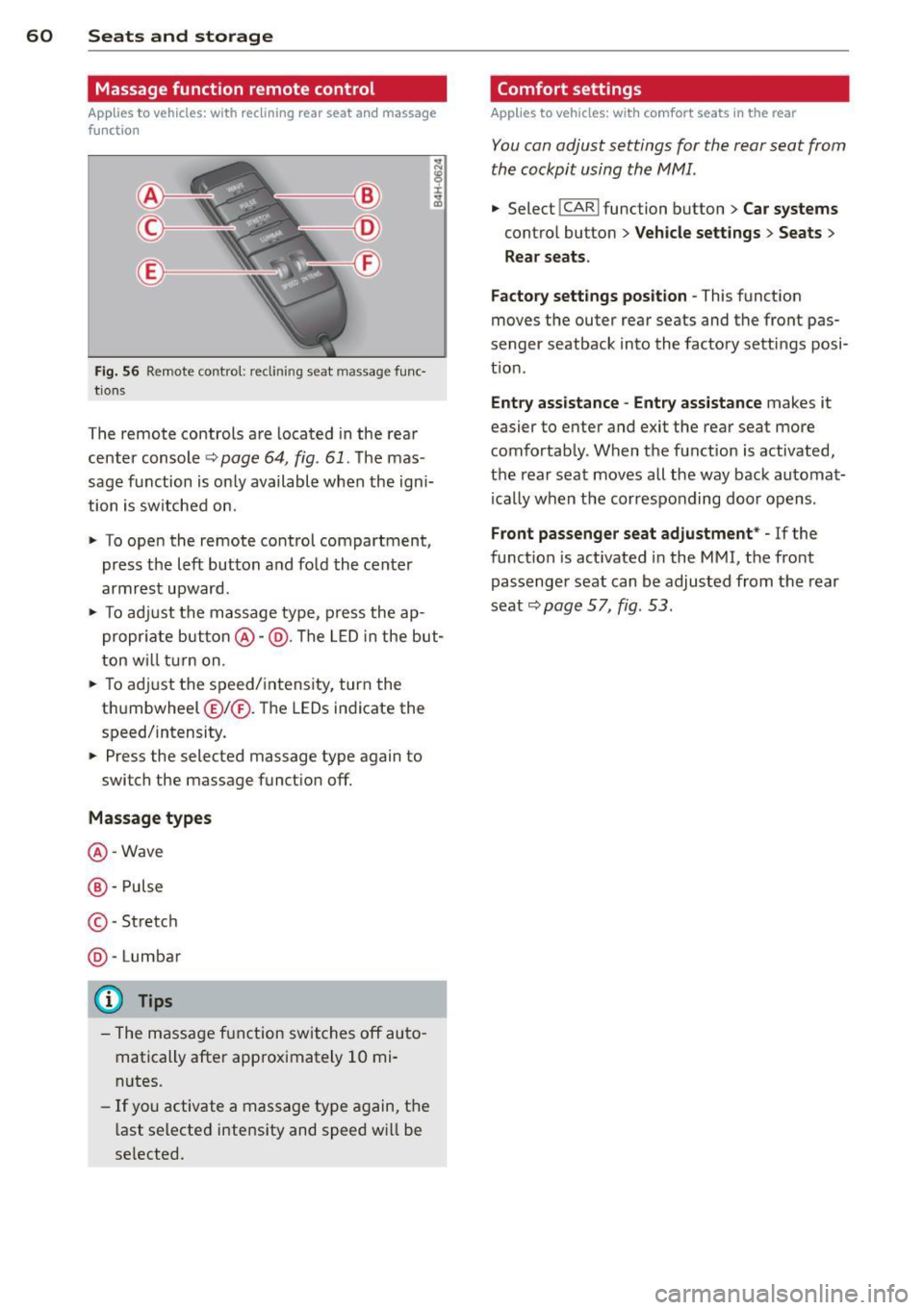
60 Seats and storage
Massage function remote control
Applies to vehicles: with reclining rear seat and massage
f u nct ion
Fig. 56 Remote contro l: recli nin g seat massage func·
tions
The remote controls are located in the rear
center console
Q page 64 , fig . 61. Th e mas
sage function is only available when the ign i
tion is switched on.
" To open the remote control compartment,
press the left button and fold the center
armrest upward .
" To adjust the massage type, press the ap
propriate button@-@ . The LED in the but
ton will turn on.
" To adjust the speed/ intensity, turn the
t hu mbwheel @I® . Th e LEDs indicate the
speed/intensity.
" Press the selected massage type again to
switch the massage function off.
Massage types
@-Wave
@ -Pulse
© -St retch
@ -Lumbar
(D} Tips
- The massage function switches off auto
matically after approximately 10 mi·
nutes.
- If you activate a massage type again, the
l ast selected intensity and speed wi ll be
se lected.
Comfort settings
Applies to vehicles: wit h comfort seats in the rear
You can adjust settings for the rear seat from
the cockpit using the MMI.
" Selec t! CAR I function button > Car systems
contro l button > Vehicle settings > Seats >
Rear seats.
Factory settings position -
This function
moves the outer rear seats and the front pas
senger seatback into the factory settings posi
t ion .
Entry assistance -Entry assistance makes it
easier to enter and exit the rear seat more
comfortably. When the function is activated,
the rear seat moves all the way back automat
i ca lly when the corresponding door opens .
Front passenger seat adjustment* -If the
function is act ivated in the MMI, the front
passenger seat can be adjusted from the rear
seat
Q page 57, fig . 53 .
Page 66 of 300
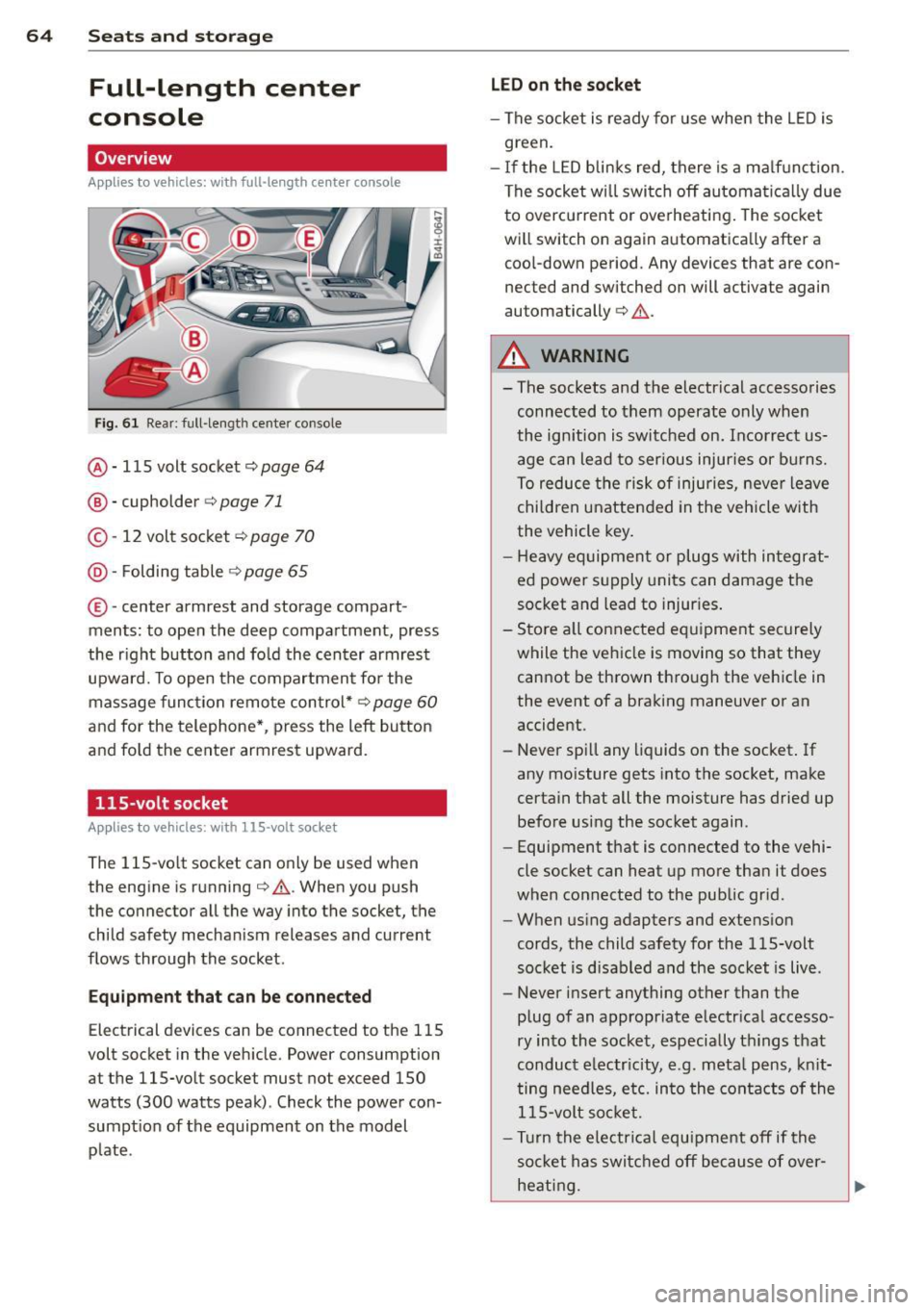
64 Seats and storage
Full-length center
console
Overview
Appl ies to vehicles: with full-len gth ce nter console
Fig. 61 Rear: full -length center console
@ · 115 volt socket ¢ page 64
@ · cupholder <=> page 71
© · 12 volt socket c:> page 70
@ · Folding table ¢ page 65
®·center armrest and storage com part ·
ments: to open the deep compartment, press
the right button and fold the center armrest
upward. To open the compartment for the
massage function remote control*
c:> page 60
and for the telephone*, press the left button
and fold the center armrest upward.
115-volt socket
Applies to vehicles: with 115 -vo lt socket
The 115-volt socket can only be used when
the engine is running¢
A. When you push
the connector all the way into the socket, the
child safety mechanism releases and current
flows through the socket .
Equipment that can be connected
Electrical devices can be connected to the 115
volt socket in the vehicle. Power consumption
at the 115-volt socket must not exceed 150
watts (300 watts peak) . Check the power con·
sumption of the equipment on the model
plate .
LED on the socket
-The socket is ready for use when the LED is
green.
- If the LED blinks red, there is a malfunction.
The socket will switch off automatically due
to overcurrent or overheating. The socket
will switch on again automatically after a cool-down period. Any devices that are con
nected and switched on will activate again
automatically
c:> A .
A WARNING
-
- The sockets and the electrical accessories
connected to them operate only when
the ignition is switched on. Incorrect us
age can lead to serious injuries or burns.
To reduce the risk of injuries, never leave
children unattended in the vehicle with
the vehicle key.
- Heavy equipment or plugs with integrat
ed power supply units can damage the
socket and lead to injuries.
- Store a ll connected equipment securely
while the vehicle is moving so that they
cannot be thrown through the vehicle in
the event of a braking maneuver or an
accident.
- Never spill any liquids on the socket. If
any moisture gets into the socket, make
certain that all the moisture has dried up before using the socket again.
- Equipment that is connected to the vehi·
cle socket can heat up more than it does
when connected to the public grid .
- When using adapters and extension
cords, the child safety for the 115-volt
socket is disabled and the socket is live.
- Never insert anything other than the
plug of an appropriate electrical accesso·
ry into the socket, especially things that
conduct electricity, e.g. metal pens, knit
ting needles, etc. into the contacts of the
115-volt socket.
- Turn the electrical equipment off if the
socket has switched off because of over·
heating.
Page 67 of 300
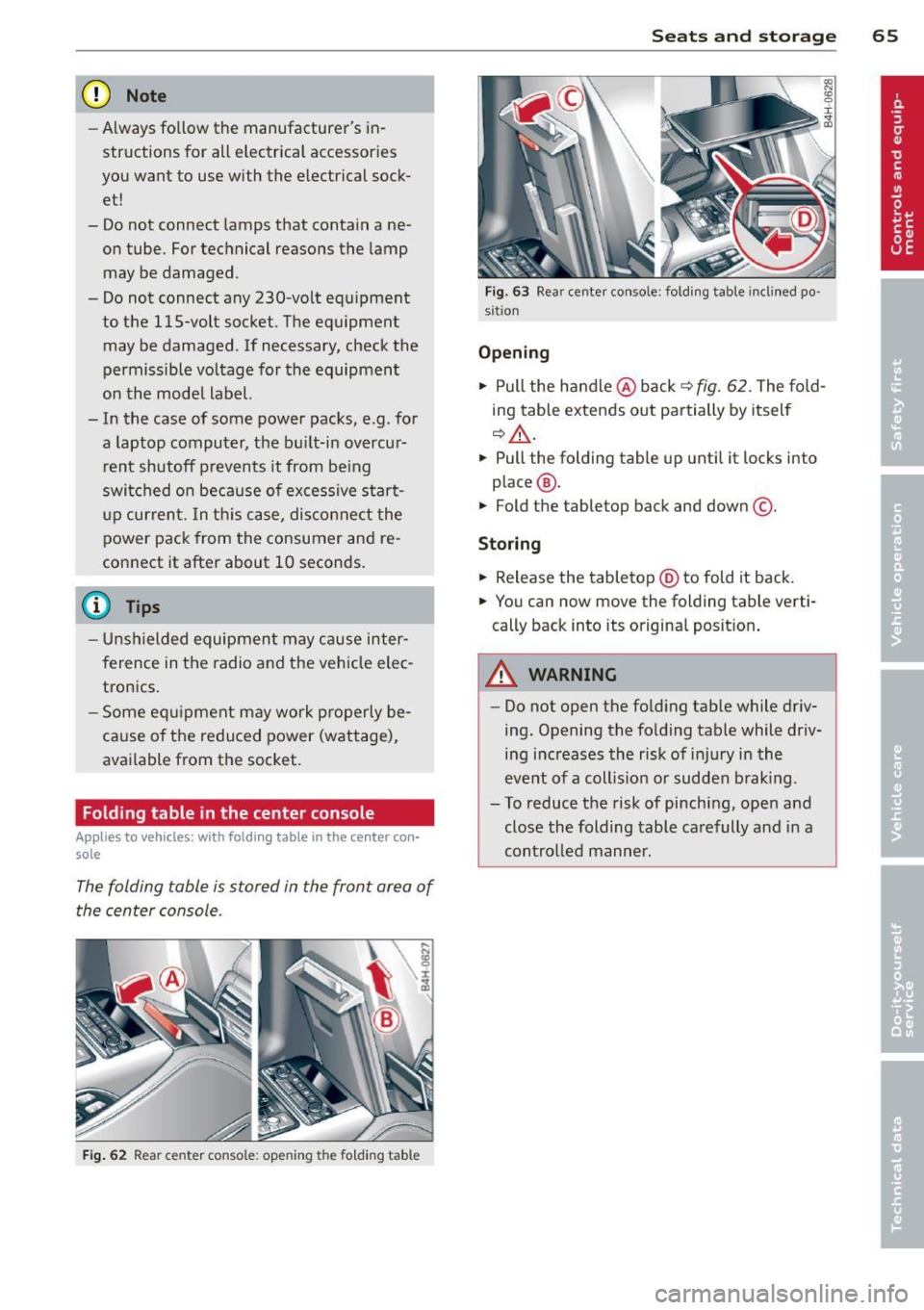
(D Note
-Always follow the manufacturer's in
structions for all electrical accessories
you want to use with the electrical sock
et!
- Do not connect lamps that contain a ne
on tube. For technical reasons the lamp
may be damaged.
- Do not connect any 230-volt equipment
to the 115-volt socket. The equipment
may be damaged. If necessary, check the
permissible voltage for the equipment
on the mode l label.
- In the case of some power packs, e.g . for
a laptop computer, the bu ilt-in overcur
rent shutoff prevents it from be ing
swi tch ed on because of excessive start
up current. In this case, disco nnect the
power pack from the consumer and re
connect it after about 10 seconds.
(I) Tips
- Unshielded equipment may cause inter
ference in the radio and the vehicle elec
tronics.
- Some eq uipment may work properly be
cause of the reduced power (wattage),
available from the socket.
Folding table in the center console
Applies to vehicles: with fold ing table in the center con·
so le
The folding table is stored in the front area of
the center console .
Fig . 62 Rear center console: opening th e fo ld in g table
Seats and storage 65
Fig. 63 Rear center console: fold ing table inclined po ·
s itio n
Opening
.,. Pull the handle @back q fig. 62. The fold
ing table extends out partially by itself
~.&. -
.. Pull the folding table up until it locks into
place @.
.. Fold the tabletop back and down©-
Storing
.. Release the tabletop @to fold it back.
.. You can now move the folding table verti·
cally back into its original posit ion .
A WARNING
-Do not open the folding tab le while driv
ing. Opening the folding table while driv
ing increases the risk of injury in the
event of a coll is ion or sudden braking .
- To reduce the risk of pinching, open and
close the folding table carefully and in a
contro lled manner .
Page 68 of 300
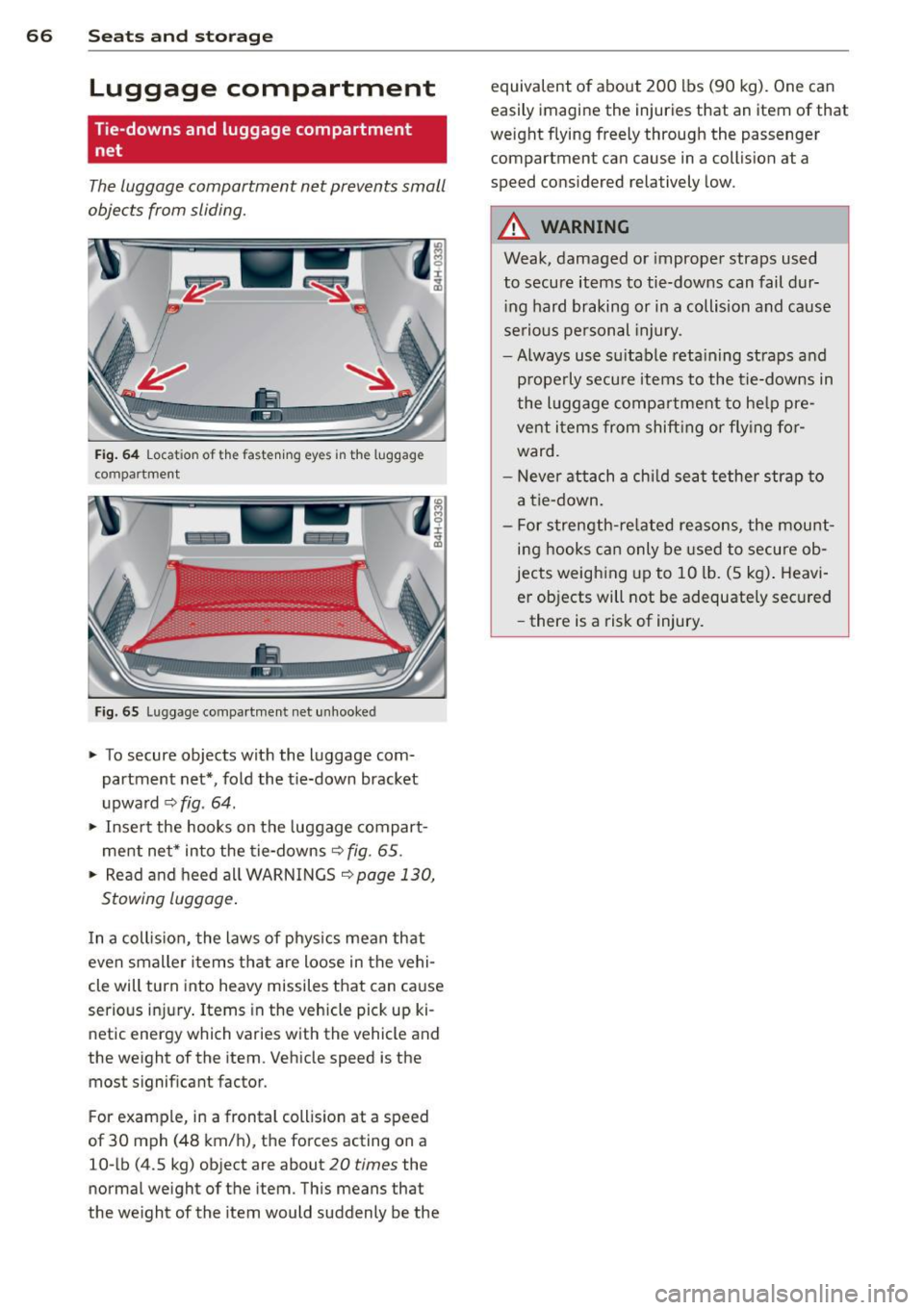
66 Seats and storage
Luggage compartment
Tie-downs and luggage compartment
net
The luggage compartment net prevents small
objects from sliding.
Fig. 64 Locat ion of the faste ning eyes in the luggag e
compartment
Fig. 65 Luggage compartment net unhooked
" To secure objects with the luggage com
partment net*, fold the t ie-down bracket
upward
9 fig . 64 .
" Insert the hooks on the luggage compart
ment net* into the tie-downs
9 fig. 65.
" Read and heed all WARNINGS 9page 130,
Stowing luggage.
In a collis ion, the laws of phys ics mean that
even smaller items that are loose in the vehi
cle will turn into heavy missiles that can cause
serio us injury . Items in the vehicle pick up ki
netic energy which varies w ith the vehicle and
the weight of the item. Vehicle speed is the
most signif icant factor.
F or example, in a frontal collis ion at a speed
of 30 mph (48 km/h), the forces acting on a
10 -lb (4.5 kg) object are about
20 times the
normal weight of the item . This means that
the we ight of the item would suddenly be the equivalent of about
200 lbs (90 kg). One can
easily imagine the injuries that an item of that
weight flying freely through the passenger compartment can cause in a collision at a
speed considered relatively low.
A WARNING
-Weak, damaged or improper straps used
to secure items to tie-downs can fail dur
in g hard braking or in a collision and cause
serious personal injury.
- Always use su itable retaining straps and
p roperly secu re items to the tie-downs in
the lu ggage compartment to help pre
vent it ems from shifting or flying for
ward.
- Never attach a child seat tether strap to
a tie-down.
- Fo r strength-related reasons, the mount
ing hooks can only be used to secure ob
jects weighing up to 10 lb. (5 kg) . Heavi
er objects will not be adequately secured
- there is a risk of injury.
Page 69 of 300
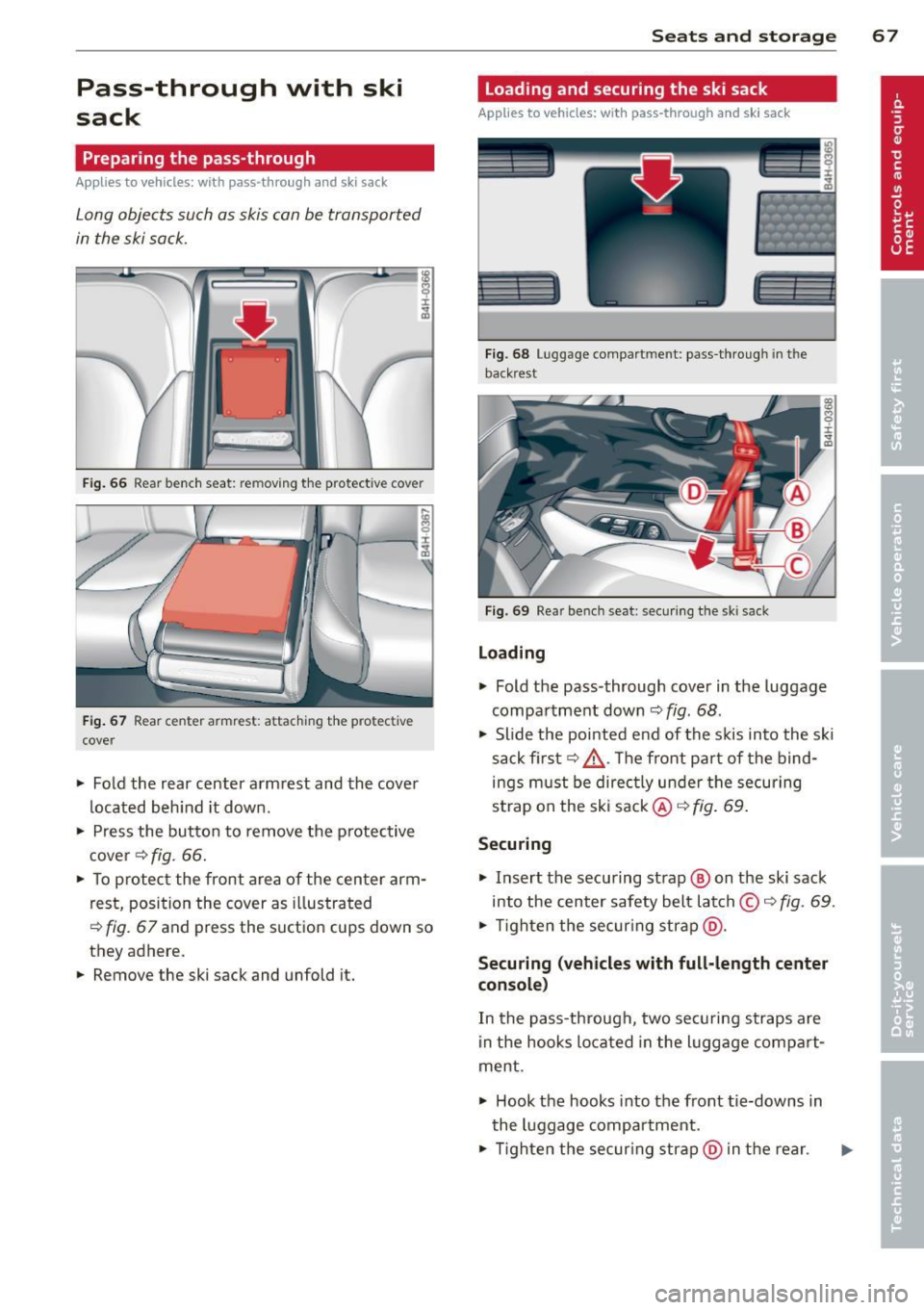
Pass-through with ski
sack
Preparing the pass-through
Applies to vehicles: with pass-through and ski sack
Long objects such as skis can be transported
in the ski sack.
Fig. 66 Rear bench seat: removing the protect ive cover
Fig. 67 Rear center armrest: attaching the protective
cover
~ Fold the rear center armrest and the cover
located behind it down.
~ Press the button to remove the p rotective
cover ¢
fig. 66.
~ To protect the front area of the center arm
rest, position the cover as illustrated
¢
fig. 67 and press the suction cups down so
they adhere.
~ Remove the ski sack and unfold it.
Seats and storage 67
Loading and securing the ski sack
Applies to vehicles: with pass -through and ski sack
--~ --
·-- --· ----~-
Fig. 68 Luggage compartment: pass-through in th e
backrest
Fig. 69 Rear bench seat: sec uring the sk i sack
Loading
~ Fold the pass-through cover in the luggage
compartment down
<=:> fig. 68.
~ Slide the pointed end of the skis into the sk i
sack first
c:> ,&. . Th e front pa rt of the bind
ings must be directly under the securing
strap on the ski sack@<=:>
fig. 69.
Securing
~ Insert the securing strap @ on the ski sack
into the center safety belt latch ©
c:> fig. 69.
~ Tighten the secur ing strap @.
Securing (vehicles with full-length center
console)
In the pass-through, two securing straps are
in the hooks located in the luggage compart
ment .
~ Hook the hooks into the front tie-downs in
the luggage compartment.
~ Tighten the securing strap@in the rear .
Page 128 of 300
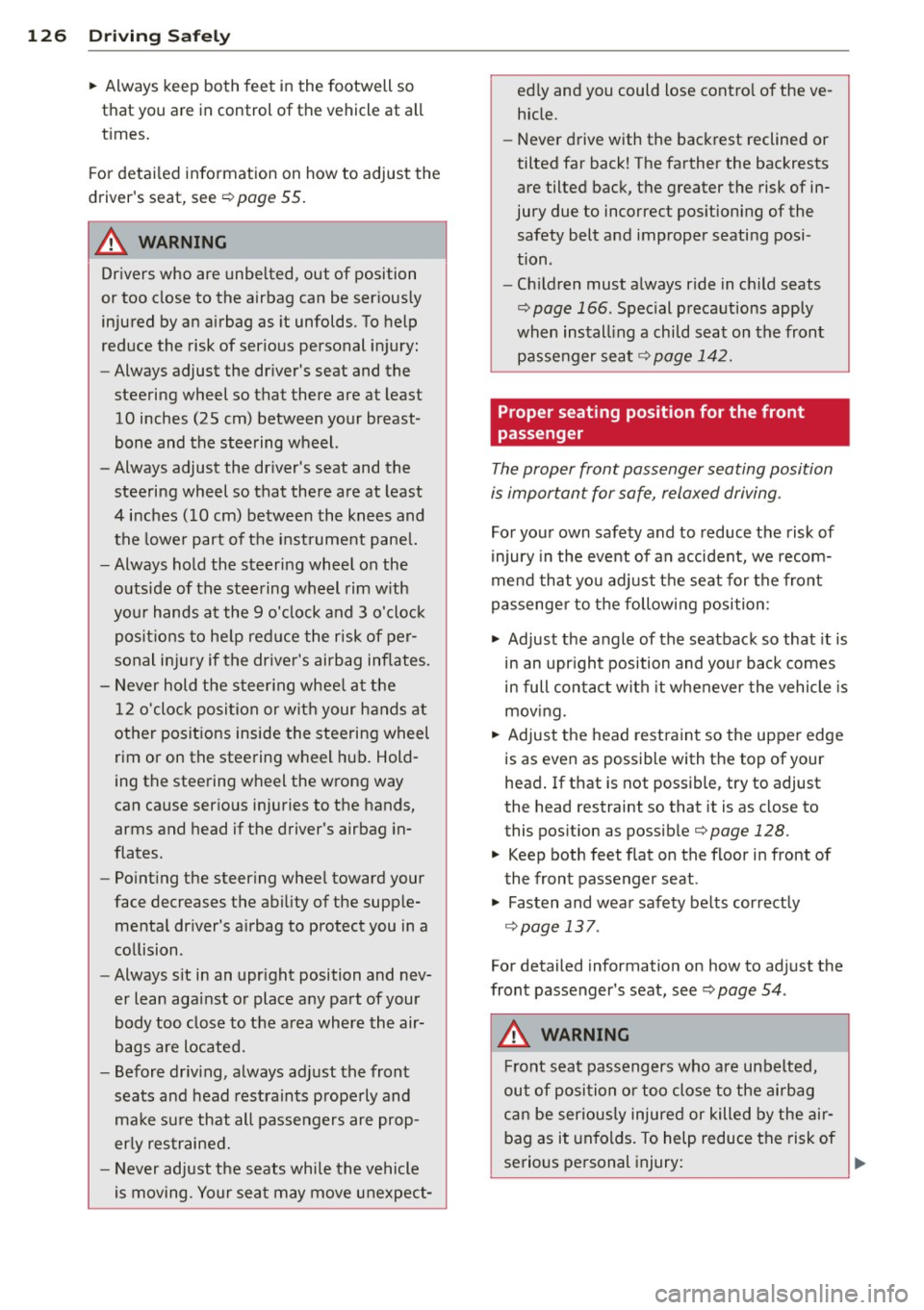
126 Driving Safely
• Always keep both feet in the footwell so
that you are in control of the vehicle at all
times.
For detailed information on how to adjust the
driver's seat, see
r:::> page 55.
A WARNING
Drivers who are unbelted, out of position
or too close to the airbag can be seriously
injured by an airbag as it unfolds. To help
reduce the risk of serious personal injury:
- Always adjust the driver's seat and the
steering wheel so that there are at least
10 inches (25 cm) between your breast
bone and the steering wheel.
- Always adjust the driver's seat and the
steering wheel so that there are at least
4 inches (10 cm) between the knees and
the lower part of the instrument panel.
- Always hold the steering wheel on the
outside of the steering wheel rim with
your hands at the 9 o'clock and 3 o'clock positions to help reduce the risk of per
sonal injury if the driver's airbag inflates.
- Never hold the steering wheel at the
12 o'clock position or with your hands at
other positions inside the steering wheel
rim or on the steering wheel hub. Hold
ing the steering wheel the wrong way
can cause serious injuries to the hands,
arms and head if the driver's airbag in
flates.
- Pointing the steering wheel toward your
face decreases the ability of the supple
mental driver's airbag to protect you in a
collision.
- Always sit in an upright position and nev
er lean against or place any part of your
body too close to the area where the air
bags are located.
- Before driving, always adjust the front
seats and head restraints properly and
make sure that all passengers are prop
erly restrained.
- Never adjust the seats while the vehicle
is moving. Your seat may move unexpect- edly and you could lose control of the ve
hicle .
- Never drive with the backrest reclined or
tilted far back! The farther the backrests
are tilted back, the greater the risk of in
jury due to incorrect positioning of the safety belt and improper seating posi
tion .
- Children must always ride in child seats
r:::> page 166. Special precautions apply
when installing a child seat on the front passenger seat¢
page 142.
Proper seating position for the front
passenger
The proper front passenger seating position
is important for safe, relaxed driving .
For your own safety and to reduce the risk of
injury in the event of an accident, we recom
mend that you adjust the seat for the front
passenger to the following position :
• Adjust the angle of the seatback so that it is
in an upright position and your back comes in full contact with it whenever the vehicle is
moving.
• Adjust the head restraint so the upper edge
is as even as possible with the top of your
head. If that is not possibl e, try to adjust
the head restraint so that it is as close to
this position as possible¢
page 128.
• Keep both feet flat on the floor in front of
the front passenger seat .
• Fasten and wear safety belts correctly
r:::> page 13 7.
For detailed information on how to adjust the
front passenger's seat, see
r:::> page 54 .
A WARNING
-
Front seat passengers who are unbelted,
out of position or too close to the airbag
can be seriously injured or killed by the air
bag as it unfolds. To help reduce the risk of
serious personal injury:
Page 129 of 300
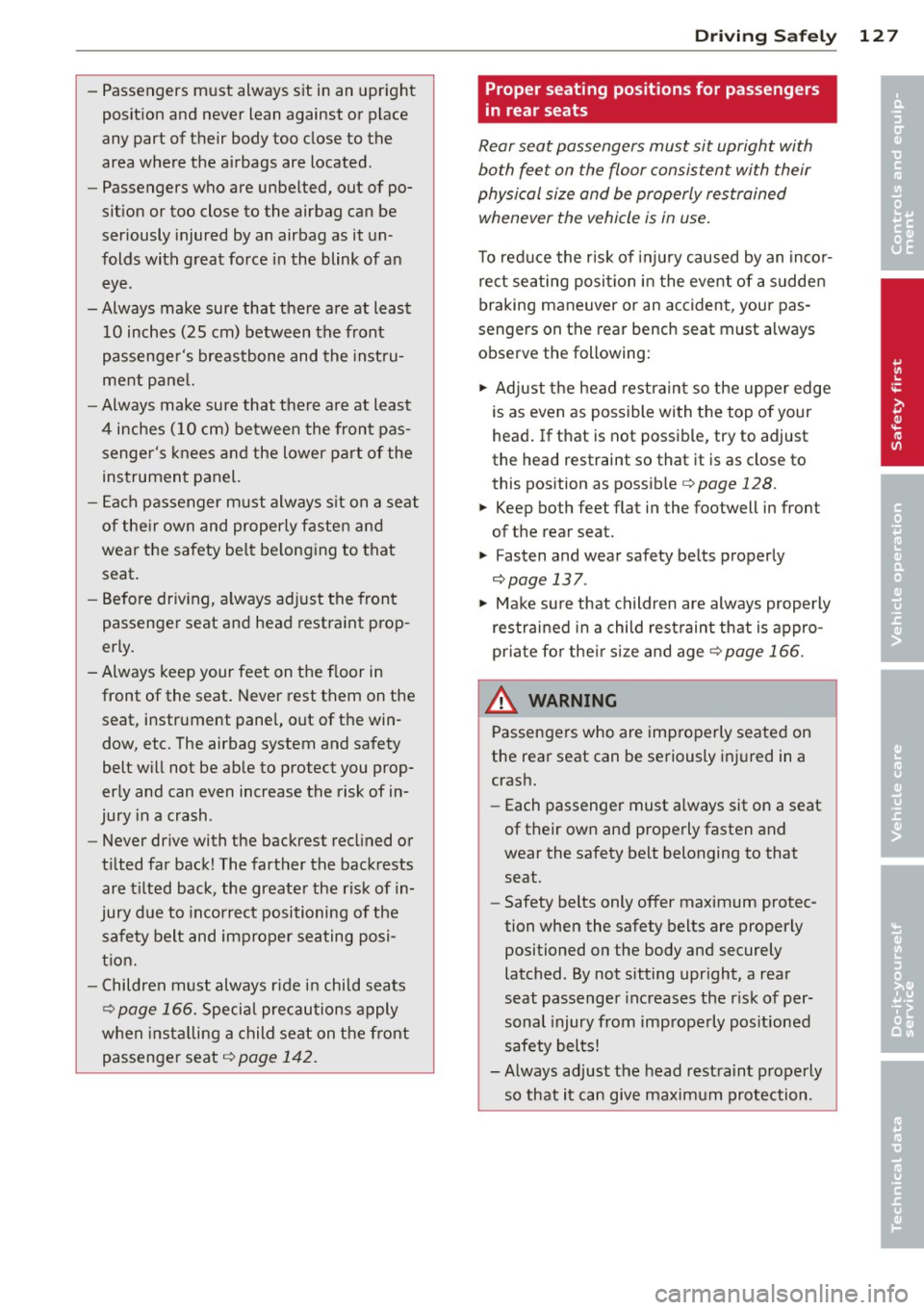
-Passengers must always sit in an upright
position and never lean against or place
any part of their body too close to the
area where the airbags are located.
- Passengers who are unbelted, out of po
sition or too close to the airbag can be
seriously injured by an airbag as it un
folds with great force in the blink of an
eye.
- Always make sure that there are at least
10 inches (25 cm) between the front
passenger's breastbone and the instru
ment panel.
- Always make sure that there are at least
4 inches (10 cm) between the front pas
senger's knees and the lower part of the
instrument panel.
- Each passenger must always sit on a seat
of their own and properly fasten and
wear the safety belt belonging to that
seat.
- Before driving, always adjust the front
passenger seat and head restraint prop
er ly.
- Always keep your feet on the floor in
front of the seat. Never rest them on the
seat, instrument panel, out of the win
dow, etc. The airbag system and safety
belt will not be able to protect you prop
erly and can even increase the risk of in
jury in a crash .
- Never drive with the backrest reclined or
tilted far back! The farther the backrests are tilted back, the greater the risk of in
jury due to incorrect positioning of the
safety belt and improper seating posi
tion.
- Children must always ride in child seats
¢
page 166. Special precautions apply
when installing a child seat on the front
passenger seat¢
page 142.
Driving Safely 127
Proper seating positions for passengers
in rear seats
Rear seat passengers must sit upright with
both feet on the floor consistent with their
physical size and be properly restrained
whenever the vehicle is in use.
To reduce the risk of injury caused by an incor
rect seating position in the event of a sudden
braking maneuver or an accident, your pas
sengers on the rear bench seat must always
observe the following:
.,. Adjust the head restraint so the upper edge
is as even as possible with the top of your
head. If that is not possible, try to adjust
the head restraint so that it is as close to
this position as possible¢
page 128 .
.,. Keep both feet flat in the footwell in front
of the rear seat.
.,. Fasten and wear safety belts properly
¢page 137.
.,. Make sure that children are always properly
restrained in a child restraint that is appro
priate for their size and age
r::, page 166.
,& WARNING
..-
Passengers who are improperly seated on
the rear seat can be seriously injured in a
crash.
- Each passenger must always sit on a seat
of their own and properly fasten and
wear the safety belt belonging to that seat.
- Safety belts only offer maximum protec
tion when the safety belts are properly
positioned on the body and securely
latched . By not sitting upright, a rear
seat passenger increases the risk of per
sonal injury from improperly positioned
safety belts!
- Always adjust the head restraint properly
so that it can give maximum protection.
•
•
Page 154 of 300
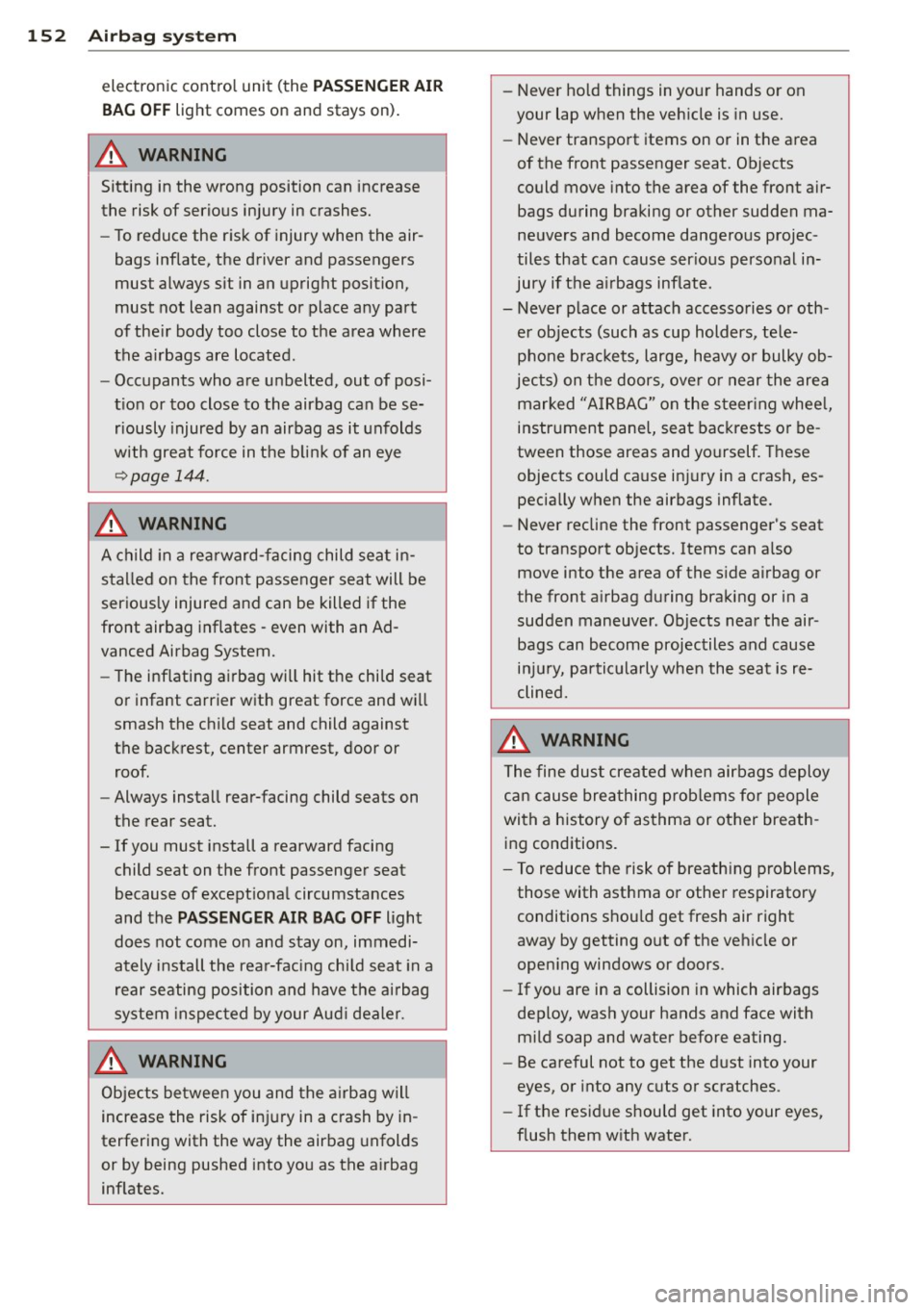
152 Airbag sys te m
electronic contro l uni t (the PAS SENGER AIR
BAG OFF
light comes on and stays on) .
A WARNING
Sitting in the wrong position can increase
the risk of serious injury in crashes.
- To reduce the risk of injury when the air
bags inflate, the driver and passengers
must always sit in an upright position,
must not lean against or place any part
of the ir body too close to the area where
the a irbags are located .
- Occupants who are unbelted, out of posi
t ion or too close to the airbag can be se
riously injured by an airbag as it unfolds
with great force in the blink of an eye
<=?page 144.
A WARNING
-
A child in a rearward -facing child sea t in
stalled on the front passenger seat will be
seriously injured and can be killed if the
front airbag inflates -even with an Ad
vanced Airbag System.
-The inflating ai rbag will hit the child seat
or infant carrier with great force and will
smash the ch ild seat and child against
the backrest , center armrest, door or
roof .
- Always install rear-facing child seats on
the rear seat.
- If you must install a rearward facing child seat on the front passenger seat
because of except iona l circumstances
and the
PASSENGER AIR BAG OFF light
does not come on and stay on, immedi
ately i nstall the rea r-facing chi ld seat in a
rear seating position and have the ai rbag
system inspected by your Au di dealer.
A WARNING
Objects be tween you and the a irbag will
increase the risk of in jury in a c rash by in
terfering with the way the airbag unfolds
or by being pushed into yo u as the a irbag
inf lates. -
Never hold things in you r hands o r on
your lap when the veh icle is in use.
- Never transpo rt items on or in t he a rea
of the front passenger seat. Objects
could move into the area of the front air
bags during braking or other sudden ma
neuvers and become dangero us projec
tiles that can cause ser ious personal in
jury if the a irbags inf late .
- Never p lace or attach accesso ries o r oth
er objects (such as cup hold ers, te le
phone b ra ck ets, large, heavy or bulky ob
jects) on the doors, ove r o r ne ar the are a
marked "AIRBAG" on the s teer ing whee l,
instr ument panel, sea t bac krests o r be
tween those areas and yourself. These
objects could ca use in jury in a crash, es
pecially when the airbags inflate.
- Never recline the front passenger 's seat
to transport objects. Items can a lso
move into the area of the s ide airbag or
the front a irbag during braki ng or in a
sudden maneuve r. Objects near the air
bags can become projectiles and cause
in jur y, partic ularly when the seat is re
clined.
A WARNING
The fine dus t create d when air bags deploy
c a n cause breathing p rob lems fo r people
wi th a history of as thma or other breath
i ng cond itions.
- T o reduce the risk of breath ing pro blems,
those with asthma or other respiratory
conditions s hou ld get fresh air right
away by getting o ut o f the veh icle or
open ing windows or doors .
- If you are in a collision in which airbags
deploy, wash your hands and face with
mild soap and water before eating.
- Be careful not to get the dust into your
eyes, or into any c uts or scratches.
- If the res id ue should get into your eyes,
f lush them w ith water.